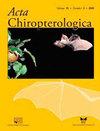在当地的酒吧见面?不使用人工水源,草原上冬眠的蝙蝠脱水的证据
IF 0.7
4区 生物学
Q4 ZOOLOGY
引用次数: 1
摘要
在冬眠时,小型冬眠动物会因蒸发水分损失而经历负水平衡。使用潮湿的冬眠器和在周期性苏醒时喝水的能力,使大多数冬眠者能够在冬季控制这种不足。一些大型棕色蝙蝠(Eptesicus fuscus)在相对干燥的岩石缝隙中冬眠,这些缝隙中没有自由积水。我们监测了加拿大大草原上一个这样的种群的冬季行为和生理。由于半干旱气候,我们假设这些蝙蝠会经历相对较高的蒸发水损失,并在隆冬时节频繁飞行寻找水源。我们测量了血清离子浓度和血细胞比容,以评估冬季捕获的蝙蝠的脱水水平。我们还提供了一个富含氘(2H)的加热水箱,并使用稳定同位素分析来测试蝙蝠血液中氢同位素比率的升高(2H/1H;此处为δ2H),以确定个体是否从水箱中饮水。我们还使用了无源声学监测、视频监控和无源集成转发器(PIT)标签来确定蝙蝠是否访问了加热水箱。随着冬天的到来,我们发现蝙蝠有高渗性脱水的证据(血细胞比容和一些血清离子浓度升高)。蝙蝠的血液δ2H与景观上的水相似,声学和视频监控没有显示蝙蝠有任何造访水箱的迹象。唤醒后脱水在冬眠动物中并不罕见,这与我们的观察结果一致,即水箱并不代表水资源,尽管它是唯一可用的开放(非冷冻)水。目前尚不清楚蝙蝠是否可以利用冷冻水源(如雪)来补充脂肪分解代谢产生的代谢水。本文章由计算机程序翻译,如有差异,请以英文原文为准。
Meet You at the Local Watering Hole? No Use of an Artificial Water Resource, and Evidence of Dehydration in Hibernating Bats in the Prairies
While torpid, small hibernators experience negative water balance due to evaporative water loss. The use of humid hibernacula and ability to drink during periodic arousals allows most hibernators to manage this deficit over the course of a winter. Some populations of big brown bats (Eptesicus fuscus) hibernate in relatively dry rock-crevices that do not contain free standing water. We monitored the winter behaviour and physiology of one such population in the Canadian prairies. Due to the semi-arid climate, we hypothesized that these bats would experience relatively high evaporative water loss and make frequent mid-winter flights to find water. We measured serum ion concentrations and hematocrit to assess level of dehydration in bats captured during winter. We also provided a heated water tank enriched in deuterium (2H) and used stable isotope analysis to test for elevated hydrogen isotope ratios (2H/1H; herein δ2H) in the blood of bats to determine if individuals drank from the tank. We also used passive acoustic monitoring, video surveillance, and passive integrated transponder (PIT) tags to determine if bats visited the heated water tank. We found evidence of hypertonic dehydration (elevated hematocrit and concentrations of some serum ions) in bats as winter progressed. Blood δ2H of bats was similar to that of water on the landscape, and acoustic and video surveillance did not indicate any visits by bats to the water tank. Post-arousal dehydration is not uncommon in hibernators, which agrees with our observation that the water tank did not represent a water resource, despite it being the only open (not frozen) water available. It is unknown whether bats may exploit frozen sources of water (e.g., snow) to supplement metabolic water produced from fat catabolism.
求助全文
通过发布文献求助,成功后即可免费获取论文全文。
去求助
来源期刊

Acta Chiropterologica
生物-动物学
CiteScore
2.50
自引率
20.00%
发文量
42
审稿时长
>12 weeks
期刊介绍:
Acta Chiropterologica, published by the Museum and Institute of Zoology at the Polish Academy of Sciences, is devoted solely to the study and discussion of bats.
 求助内容:
求助内容: 应助结果提醒方式:
应助结果提醒方式:


